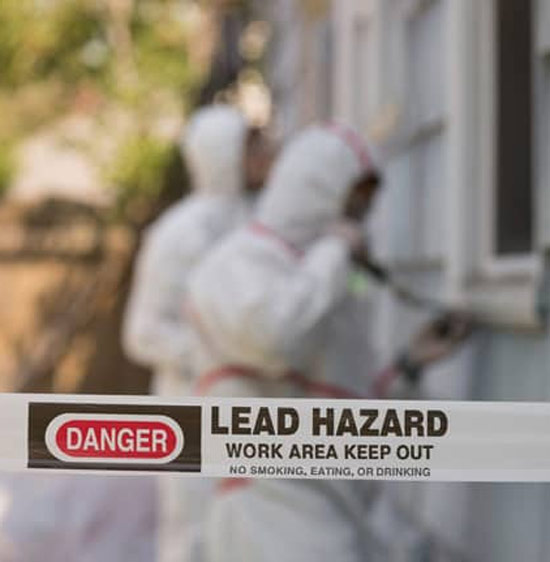Trusted Lead Paint Removal Company-- NYC's Premier Lead Abatement Service
Essential Devices and Approaches for Effective Lead Violation Clean-up
Dealing with lead offenses efficiently necessitates a thorough technique that mixes the right tools with tactical methods. Concurrently, the usage of specialized cleanup tools, such as HEPA vacuum cleaners and lead-specific cleaning representatives, is imperative for detailed contaminant elimination. Efficient control approaches, including plastic sheeting and negative air pressure systems, are vital to protect against the spread of hazardous products.
Personal Protective Equipment
Personal safety tools (PPE) is a critical component in the reliable monitoring of lead contamination cleanup. The vital PPE for lead clean-up includes respirators, protective clothing, handwear covers, and eye defense.
Respirators, specifically those furnished with HEPA filters, are important for filtering air-borne lead particles, protecting against breathing. Protective garments, including coveralls and non reusable suits, protects against lead dust from sticking to workers' garments, lowering the risk of additional contamination.
Furthermore, extensive training on the proper usage and upkeep of PPE is necessary. Workers need to be informed on wearing and doffing treatments to prevent contamination. Normal assessments and substitutes of PPE components are essential to maintain their safety capabilities, making sure a secure and compliant cleaning procedure.
Specialized Clean-up Devices

An additional important device is the wet/dry vacuum cleaner, which can effectively clean up both dirt and fluid contaminants. These vacuums usually feature HEPA filters to give an additional layer of safety and security. Damp wipes or tack fabrics are additionally important for surface area cleansing; they are specifically developed to catch and hold lead fragments, reducing the risk of spreading contamination.
For more persistent down payments, specialized lead-removal cleaner are called for. These representatives are formulated to break down lead particles, making them less complicated to get rid of. Scrub brushes with sturdy bristles can aid in this process, particularly on rough surface areas where lead dust tends to adhere much more strongly.
Additionally, encapsulants are utilized to seal lead-contaminated surface areas, stopping the launch of lead dirt. These specialized paints and layers are made to stick to numerous substratums, giving a lasting option for lead control.
Efficient Containment Methods
Effective containment methods are crucial in mitigating the spread of lead contamination throughout cleaning activities. Executing robust containment approaches makes certain that lead fragments do not move to unaffected areas, therefore shielding both employees and the environment. One primary approach is the usage of plastic sheet to seal polluted zones. Sturdy polyethylene obstacles can be set up from floor to ceiling to develop a regulated workplace, considerably reducing the threat of airborne lead dust dispersal.

To enhance control, encapsulants can be related to surfaces that are not being gotten rid of or interrupted. These specialized layers bind lead dust, reducing its schedule for resuspension. Furthermore, all workers must use ideal Personal Protective Equipment (PPE), including respirators and non reusable fits, to stop contamination spread.
Safe Disposal Practices
Making certain risk-free disposal methods is a crucial part in the management of lead contamination clean-up. Proper disposal minimizes the threat of lead coming back the environment and endangering public health (DOH & HPD find more information Lead Violation Removal NYC).
Moving lead waste needs adherence to rigorous standards. Utilizing certified contaminated materials service providers guarantees that the products are managed properly. Paperwork, including shows up describing the type and quantity of waste, need to go along with shipments to track the waste from the site of beginning to its last disposal location.
Designated contaminated materials disposal centers are geared up to manage lead-contaminated products safely. These facilities often employ innovative techniques such as stablizing, solidification, or chemical therapy to neutralize the lead prior to disposal. Landfilling in specialized, lined areas that avoid leachate from infecting groundwater is an usual practice for last disposal.
Normal training for workers involved in lead waste disposal is critical to preserve security standards and avoid accidental exposure. By adhering to these practices, organizations can substantially decrease the ecological and health impacts connected with lead contamination.
Regulatory Compliance Tips

Sticking to regulative compliance is vital in the successful implementation of lead contamination cleaning. Understanding and complying with federal, state, and regional guidelines guarantees not only the safety and security and health of individuals yet additionally the legal and financial well-being of the clean-up company. The Epa (EPA) sets strict standards, such as the Lead Remodelling, Fixing, and Paint (RRP) Policy, which mandates correct certification and training for specialists managing lead-based tasks.
Compliance begins with a thorough analysis of appropriate regulations and regulations. Organizations should stay upgraded on any legislative adjustments, which can be assisted in through have a peek here normal training sessions and signing up for sector updates. Paperwork is another important conformity aspect; keeping detailed records of all activities, consisting of inspection reports, staff member training logs, and disposal materializes, is important.
In addition, engaging with accredited lead examiners or risk assessors makes certain that lead risks are appropriately determined and mitigated. Employers have to apply using Personal Protective Tools (PPE) and guarantee that safety and security procedures are purely followed. Finally, transparent interaction with stakeholders, consisting of staff members, clients, and regulative bodies, will cultivate a culture of compliance and accountability, eventually contributing to a much safer and extra effective lead clean-up process.
Verdict
Effective lead violation cleaning demands the combination of specialized devices and strategic techniques to ensure safety and security and effectiveness. Personal safety devices (PPE) safeguards workers from exposure, while secure disposal methods and strict adherence to governing compliance are necessary for sensibly handling dangerous waste.